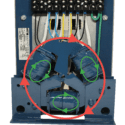Download a PDF version of this page Download a PDF version of this page
Defining the added benefits of the dV Sentry™ versus a shaft grounding brush.
What’s a Shaft Grounding Brush?
A common method across industries is to use a shaft grounding brush or ring to protect motor bearings from common mode over voltage. A shaft grounding brush is not a filter, so it does not help reduce or protect equipment from the actual problem. The current is detected around the motor bearing to an alternative route, thus the current still exists and can cause widespread damage in many other areas in the system.
Effects of Using a Shaft Grounding Brush
Due to their design and placement on motors, shaft grounding brushes have long term costs. The position and contact of these products with the shaft make them prone to wear and a shorter life span, and are not always easy to replace. A shaft grounding brush is also subjected to high levels of oxidation which causes the product to reduce its ability to divert currents from VFDs. All of which result in higher maintenance costs.
One of the most problematic issues in using a shaft grounding brush is that it does not reduce the effects associated with common mode over voltage, fast rise time, and peak voltages. This issue can cause failures to surrounding equipment such as: erratic behavior of VFDs and PLCs, insulation failure leading to motor overheating, and unwanted ground faults.
Destructive Waveforms
Common Mode Over Voltage
VFDs give off power in a continuous generation of pulses, which on average achieve a sinewave. However, the sum at any point is not always zero, which results in damaging common mode over voltage. This can cause motors to break down over time.
Peak Voltages
The pulse of VFDs is not a clear square pulse. Each rise and fall of the pulse has an over shoot or transient over voltage. This phenomenon is also known as a “reflected wave.” These voltage spikes, especially in long cable leads, can reach dangerous levels and damage drives and motors.
Rise Time
Modern VFDs utilize IGBT systems that create extremely fast rise times which can increase motor performance. However, this can also result in increased motor insulation heating, which can reduce motor life in the long run.
________________________________________________________________________________________________________________________________________________________
Unresolved Issues Associated with a Shaft Grounding Brush:
- Unexpected ground fault trips
- Erratic behavior of VFDs and PLCs
- Premature motor insulation failure
- Cable damage
________________________________________________________________________________________________________________________________________________________
The Best Solution for Motor Protection is the dV Sentry™
The dV Sentry™ is the only filter on the market that features a one of a kind patented Triple Defense Core that is proven to reduce common mode current by 50%. Also, the Triple Defense Core helps reduce peak voltages and rise time. No other filter on the market can make the same claim.
The dV Sentry™ is the only proven filter to provide common mode reduction, peak voltage protection, and rise time reduction – all in one unit.
 The dV Sentry’s Unique Patented Triple Defense Core
The dV Sentry’s Unique Patented Triple Defense Core
The patented design of the dV Sentry™ and its Triple Defense Core are like nothing you’ve seen before.
- Common mode reduction: Filters power through the outer core and reduces common mode current.
- Peak voltage protection and rise time protection: Power filters through inner core, reduces rise time, and gives peak voltage protection.
| Filtering | Filter Common Mode Dampening | Change in Common Mode Current | Note |
|---|---|---|---|
| Typical dV/dt Filter | N/A | -5% | Negligible Common Mode Filtering |
| Common Mode Choke | None | 18% | Unreliable Common Mode Filtering |
| Shaft Grounding Brush | N/A | 0% | Can Protect Bearings |
| MTE dV Sentry Filter | Optimal | -47% | Reliable Common Mode Filtering |
dV Sentry vs. the Rest
The dV Sentry outperforms the competition with proven results. Of the three filters tested, a typical dV/dt filter, a common mode choke, and the dV Sentry filter, the dV Sentry showed that it was a standout among the competition. Each filter was tested using a 480V, 50 hp drive system with 1,000 feet of cable, 8 kHz switching frequency, and at full load. While many of the competitors claim to reduce common mode voltage, they fail to back it up.
Want to learn more?
- White paper for detailed specifications about Common Mode and its effects
- dV Sentry video
- More power quality solutions from MTE
Did You Know: Your system could experience peak voltages and rise times that exceed the NEMA MG-1, Part 31 Standard for inverter duty motors.
